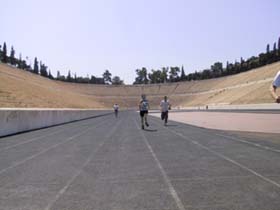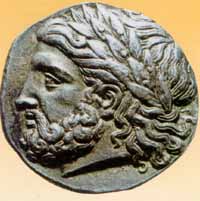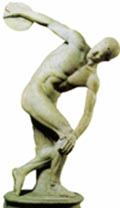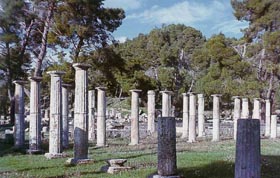
The history of the summer Olympics
 The first athletic contest, the foot race, was held at the sacred place of Olympia,
in western Peloponnesian,
for the first time in 776 BC, in honour of the Olympian Zeus.
The Olympic festival gained considerable importance, ranked among the largest and most famous Pan Hellenic
festivals by the time of early 5th century. Ancient Greeks thought that heroes and gods organized the first games
held in Olympia. Ancient Egyptians and the people of Mesopotamia had a long tradition in athletic activities, as
shown by the relief's depicting athletic scenes carved on the tombs of their kings and their nobles. They did
not hold regular festivals, however, and when they did, it seemed that kings and the higher class only attended
these. The Minoans showed special concern in gymnastics. Members of the noble class practiced such activities in
places near the palace, probably. The Myceneans adopted all Minoan games, and introduced chariot-racing and more
track contests.
The first athletic contest, the foot race, was held at the sacred place of Olympia,
in western Peloponnesian,
for the first time in 776 BC, in honour of the Olympian Zeus.
The Olympic festival gained considerable importance, ranked among the largest and most famous Pan Hellenic
festivals by the time of early 5th century. Ancient Greeks thought that heroes and gods organized the first games
held in Olympia. Ancient Egyptians and the people of Mesopotamia had a long tradition in athletic activities, as
shown by the relief's depicting athletic scenes carved on the tombs of their kings and their nobles. They did
not hold regular festivals, however, and when they did, it seemed that kings and the higher class only attended
these. The Minoans showed special concern in gymnastics. Members of the noble class practiced such activities in
places near the palace, probably. The Myceneans adopted all Minoan games, and introduced chariot-racing and more
track contests.
The Homeric poems comprise the first written evidence of athletic contests in the Greek world. In his great poems, Homer gives vivid descriptions of the athletic contests held as part of the funerary ceremonies in honour of the dead hero, Patroclus, or in other occasions. The emergence of the first city-states caused a rapid development in athletics, which was held in festivals of religious character and the organisers were providing vehicles for recurring competition among the members of the polis. Olympia soon became an important religious place, where a series of athletic contests were held. This great religious celebration "Olympic Games" became the symbol of political and cultural unity of Greeks in the historical period.
The Olympic Festival in Antiquity
 The Olympic festival was the most important and ancient of all other Greek festivals. It was the greater religious
festival among others, dedicated to Zeus, the supreme of all gods. The sanctuary of Olympia imposed its authority
throughout the Greek world, whereas soon the Olympic Games became the symbol of Panhellenic unity. The Olympic festival
was held once every four years in the most hot days of the summer. During the five days of the festivals, a number of
sacrifices were dedicated to the altars of the gods of Olympia, the most magnificent of all being the sacrifice of one
hundred cattle in front of Zeus' altar. The victors were crowned with a wreath of wild olive and enjoyed special honours
from their hometown.
The Olympic festival was the most important and ancient of all other Greek festivals. It was the greater religious
festival among others, dedicated to Zeus, the supreme of all gods. The sanctuary of Olympia imposed its authority
throughout the Greek world, whereas soon the Olympic Games became the symbol of Panhellenic unity. The Olympic festival
was held once every four years in the most hot days of the summer. During the five days of the festivals, a number of
sacrifices were dedicated to the altars of the gods of Olympia, the most magnificent of all being the sacrifice of one
hundred cattle in front of Zeus' altar. The victors were crowned with a wreath of wild olive and enjoyed special honours
from their hometown.
During the Olympic festival, a number of athletic contests were held:
- stadion race
- wrestling
- boxing
- pankration
- equestrian events
- pentathlon (jumping, running, javelin, discus, wrestling)
First, all cities had to cease hostilities during the days of the games. Secondly, all Greeks were allowed to participate, except barbarians, women and slaves. Thirdly, a number of specific rules regulated the training procedures and the performance of the games.
Training at athlete's hometown

An athlete started training during childhood at his hometown. Training intended to develop physical abilities as well as improving technique and style. The trainers belonged to one of the following categories: Paidotribes (physical trainers), gymnastes (trainers for athletic exercises, commanding high fees) and aleiptes (anointers). The latter's job was to anoint with oil the athletes' bodies, in order to massage the muscles. If an athlete could not afford the training expenses in order to participate in the Olympic Games, his city would undertake the responsibility to hire a trainer to accompany him.
Importance of the Olympic games
The Olympic festival and being victorious in the games become the symbol of spirit and unity in Antiquity. Athletic victory became inextricably linked to the victory of his city and the city became the only collective body with rights to assign glory and awards.
Secondly, it was the credit to the personal achievement and the wide recognition of the athlete's physical and moral virtues. Then, it was the moral reward that made the victory worthy of all efforts and physical pain. Lastly, it was the challenge for the Greek world to promote cooperation and exhibit political unity. These national gatherings became famous Pan -Hellenic festivals that promoted cultural consciousness and strengthened Greek identity.
Site in time

Olympia is located 10km inland in the territory of Elis in the north-western Peloponnesus. Near the point where the two rivers meet, there rises a low hill covered with pines. This bears the name of Kronos, the father of Zeus, and surrounds the flat area of the shrine. Combining the different mythological, historical and archaeological strings, it seems probable to assume that already by the 10th century BC Olympia was a cult place, known to the elites of the western Peloponnesus, who dedicated a lot of offerings in honour of its cult(s). Obviously, Olympia came to be a regional cult place for people of different interests and status. In a region divided into small-scale local territorial units, neutral religious centers functioned as meeting places of local elites.
- The site of Olympia developed from a local cult centre to a Panhellenic sanctuary throughout the course of the centuries.
- In the Geometric and Archaic periods (10th-6th centuries BC), the site was reorganized to meet the increasing needs created by the visitors of the site. In the early 6th century BC, the first temple, dedicated to Hera, was erected.
- In the Classical era (5th and 4th centuries BC), the sanctuary complex was reorganized to accommodate the most magnificent temple of the site: the temple of Zeus, containing the most famous cult statue of Zeus, made by the famous sculptor Pheidias. The site was supplied with a number of new secular buildings and athletic facilities.
- In the late Classical (4th century BC) and Hellenistic periods the site was decorated with buildings dedicated by Philip II of Macedonia, father of Alexander the Great, and other wealthy donors.
- In the Roman period the sanctuary acquired an international fame and enjoyed imperial benefits. Following the political crisis in the late Roman period, the decline of Olympia was accelerated. In AD 393, Theodosios I, the emperor of east Roman Empire, put an end to the Olympic games.